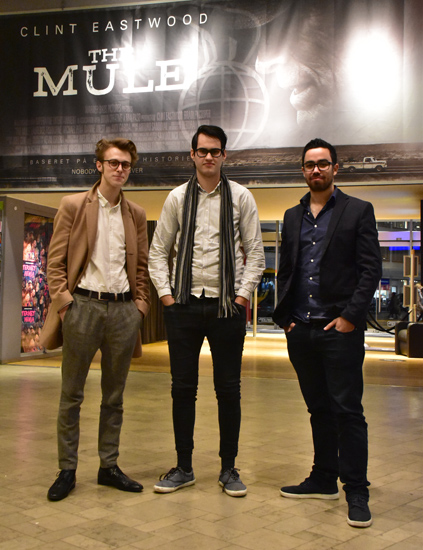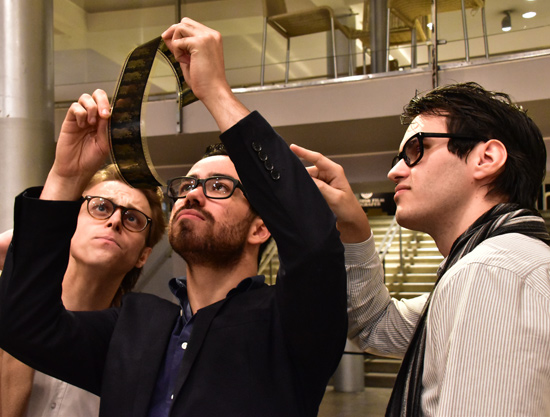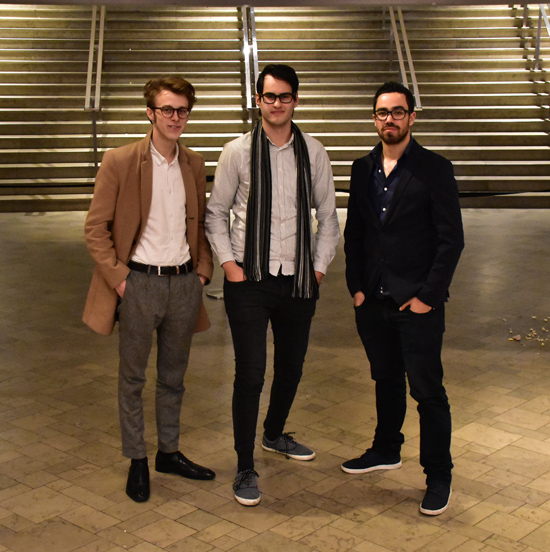From YouTube To 65mm Film
|
Read more at in70mm.com The 70mm Newsletter |
| Written and photographed by: Thomas Hauerslev | Date: 29.04.2019 |
 "We
have an ambition to make Danish films, with a Danish 70mm camera". Move over
Clint, here comes the YouTube generation who want to make old-school 7OMM
films. From left: William Rudbeck Lindhardt, Simon Wasiolek and Ben
Brahem Ziryab at the
Imperial Bio in Copenhagen on Friday, January 4, 2019. "We
have an ambition to make Danish films, with a Danish 70mm camera". Move over
Clint, here comes the YouTube generation who want to make old-school 7OMM
films. From left: William Rudbeck Lindhardt, Simon Wasiolek and Ben
Brahem Ziryab at the
Imperial Bio in Copenhagen on Friday, January 4, 2019.Danish Film director Simon Wasiolek (22) is currently completing his new short film "The Diamond Girl". It is an exciting project because the short film is made on 35mm film. The entire production process has been done in the classic photochemical way and has not involved any digital steps. in70mm.com's reporter met Simon, and his friends, Cameraman Ben Brahem Ziryab (26) and producer William R. Lindhardt (21) for a chat about real film. It was an inspiration to listen to these three young Danish filmmakers and learn about their bold courage and fearless 65mm film ambitions. Here, Simon, Ben and William discuss their enthusiasm for old-fashioned film making, and their new film project, which would involve the new Magellan 65 "70mm" film camera, which is produced by Tommy Madsen in Frederikshavn (DK). Simon Wasiolek: After we produced "The Diamond Girl", Ben, William and I discussed that our next project should also be on film because I love working with film. Whether it should be 16mm or 35mm was not clear. It would just be on film. I like working with film. I like the way it looks and how it feels. At that time we heard about the new Danish 65mm camera "Magellan 65", which opened our eyes to the possibility of filming on 65mm film. The new 65mm camera has opened up some possibilities that we have not seen before. We think this is interesting because the conventional "old school" idea with 65mm, are these old epic war films and big films, with great pictures of landscapes. What is really exciting with 65 is if you go "up close and personal" with a face, magic starts to happen. 65mm makes it more lifelike and easier to get close to the character - it can't really be explained ... -, and with the Magellan, because it's so light, there is this possibility to use it handheld in a more fluid way, and through that, one might do more that hasn't been possible before, because the cameras have been so big and hard to work with. I hope it is possible to use Magellan 65. • Go to The Invisible Magic Power of 70mm • Go to Director of Photography Ben Brahem Ziryab Thomas: How would you describe your feature film project? Simon: It is a Danish film that takes place just after World War II in Denmark, but seen through a foreigner's eyes. The working title is "A Hero of Our Time". The story begins in 1945/46. We follow two young Germans refugees who hope to find a new and better life in Denmark. I love "period movies" and books written 200 years ago about how people lived. It's like a time machine - or at least as close to a time machine as you can get. I find it deeply interesting to read about what people thought of then. The time after World War II was odd because as the era was inspired by the hope that "it couldn't be much worse", but on the other hand, if it really was that bad, it might well could get worse? It's a paradoxical feeling, and that's the emotion I'd like to explore in this movie. I would like to show what they were talking about and what they thought of then in a strong and visual form - a kind of journey through Denmark. |
More in 70mm reading: The Invisible Magic Power of 70mm Director of Photography Ben Brahem Ziryab in Conversation in70mm.com Interview & People Internet link: |
 "70mm makes the impression. The light, the details, and how realistic it is.
You feel you can touch it and that you are in the movie. It's like 3D
without glasses." William, Ben and Simon look at 70mm film. "70mm makes the impression. The light, the details, and how realistic it is.
You feel you can touch it and that you are in the movie. It's like 3D
without glasses." William, Ben and Simon look at 70mm film.THa: What is it that appeals to you with 70mm film? Simon: My first 70mm experience was "The Hateful Eight", and what really impressed me were the close-ups of the actors, the light, the details, and how realistic it felt. As Ben says, it almost felt like you could touch it and that you were in the movie. It's like 3D without glasses. The same is true of "The Master", which I have only seen digitally. It's the faces and the sense of reality. It's magical in some way. THa: Isn't it a challenge to photograph on film? Is there a Danish production environment for film? Simon: I experienced that when I made my short film "The Diamond Girl" on 35mm film. Making people interested was a challenge. People were definitely interested, but they didn't think it was realistic. I talked to 20-30 people from the film community. They all liked my idea, but thought it was too cumbersome and too expensive. "Do it digitally and find out in a different way". But I stuck faithfully to my original idea, "No, it must be on film". Because I want to try - just once in my life - to make a movie on FILM. The only way I could make the movie was to spend my own money. THa: How would you finance "A Hero of Our Time" on 65mm film? Simon: Our first priority is to produce a teaser in 65mm this year for everyone to try their hand at the format. From this teaser we hope be able to attract enough interest from people and to get funding. The plan is to show the teaser to production companies so they can see that it works and that it looks great. Of course, it costs some money, but it does not cost much more to photograph on 65mm film compared to digital photography. The budgets are so large that we can easily do it on film instead. You just don't do it these days. THa: Are you more careful when shooting on film? Simon: My experience from the "The Diamond Girl" was, firstly, that there is much more focus and respect on the set when the camera is running. It's money being spent. If you make a mistake, it will cost you money. You are more careful during pre-production, and as Ben mentions when you make a photochemical process: "What you shoot, is what you get". You can't fix it later in post production. Somehow, even if someone may disagree, I think it will give a better result. |
|
 "So, if you love
the movies, then how can you
NOT support the concept to keep shooting on film?" William, Simon and Ben. "So, if you love
the movies, then how can you
NOT support the concept to keep shooting on film?" William, Simon and Ben.William Rudbeck Lindhardt: With the team we gathered for the short film "The Diamond Girl", we had experienced, as well as relatively inexperienced people on set, and also in the pre-production where we got people engaged. There was a quivering enthusiasm for making this a success. We made a community about making this movie, which was something special. It was not just something trivial, it was extraordinary. On the set there was a respect for the medium. When the camera was rolling, everyone was ready and everyone did their utmost to make this happen. THA: Film is new black isn't it? Ben Brahem Ziryab: It is, in the sense that if you look at the film vs. digital debate, then you can say that the new generation has not experienced film like the old generation. We have been to the cinema, but have not grown up with film. We grew up with YouTube, digital cameras and mobile phones. We live in a digital world, so seeing something that is analogue is new to us. It's new to our generation. To see something you are not used to. It's a completely different image quality. It is a completely different feeling you get when you see an analog image. I think it's exciting. Simon: I've had many interesting conversations about digital and film. As an example, I have talked to some young producers, who think, that if you have to shoot on film, then there must be a very special reason. I'm against that mindset because it doesn't have to be a special reason for shooting on film. The movies we love are the films from the 50s, 60s and 70s. All those film makers I look up to, they made movies on film. So if you love the movies, then how can you not support the concept to keep shooting on film? I don't think that makes sense. For me, it is an inspiration to make a movie in the same way that Charlie Chaplin made his movies. It is completely magical and special for me. Ben: There will always be a reference to film as a media, all the way back to the classic films like "Lawrence of Arabia" and "2OO1: A Space Odyssey". From my point of view as a cameraman, using film really pays off, and it is not more difficult or expensive than shooting it digitally. THa: What is the cool thing about film? William: What is exciting for us is to be able to make something that people want to see. I mean, to make it an event to go to the cinema. Moreover, we have an ambition to make Danish films, and if we can make it with a Danish 70mm camera, then it is quite obvious with this production. Then there is the aspect of why the audience want to see this movie, and that is that you need to get an experience out of this, and to be engrossed into the movie. They must experience a magnificent format, so it will be a special day. |
|
| Go: back - top - back issues - news index Updated 22-01-25 |
